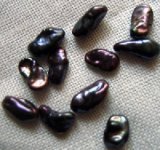M
mikehrz
Guest
Does anyone else think we need a sticky for this forum containing some faqs? It would make it easier for new forum members to find advice on their prospective purchases. Things like:
-Truly natural (non-cultured) pearls are incredibly rare. Some sellers may declare their pearls to be "natural" simply because they are not imitation or faux pearls. Others dishonestly claim that their pearls are truly natural even though they are cultured. If you find a "natural" item that interests you, ask questions of both the seller and the experts here to ascertain its true nature. Natural pearls are far more valuable than cultured pearls owing to their rarity.
-"Certifications" from "gem laboratories" or the like are usually not worth the paper they're printed on. Especially beware of sellers listing items that are "equivalent quality" to the item submitted to the lab. What this really means is that no supposed "expert" has actually examined the item for sale. This renders what was an already mostly useless "certification" even more so.
-Grading scales are NOT universal. "AAA" or "AAAA" ratings are assigned by each seller individually according to their whim and are NOT comparable to items with a similar rating from other sellers. Like "certifications," grading scales are generally meaningless.
-Feedback is generally irrelevant. The brutally honest truth: If you're here looking for advice on buying pearls on eBay, you're probably not a pearl expert. The vast majority of people buying pearls on eBay are just like you. Even if the seller has lots of positive feedback, most of that feedback probably came from people who aren't pearl experts, and therefore is not a reliable indicator of the quality of the items you can expect from that seller. Who would you rather take advice from: Someone who knows as much (or as little) about pearls as you do, or someone who evaluates and scrutinizes pearls for a living?
-Beware sellers who don't respond to questions. If you went into a brick-and-mortar jewelry store and the salesperson remained mute when questioned, would you buy from them?
-Black pearls do NOT occur naturally. The only common dark-colored pearls are Tahitians, and they have a distinctive look which does not resemble the look of dyed akoya or fw pearls. An oil-slick look is a dead giveaway that the pearls are dyed.
-As in the real world, you get what you pay for on eBay. Good deals can be found, but as in the real world, they're not very common. If it sounds too good to be true... it's probably Chinese freshwater (read "it probably is").
Feel free to make suggestions/comments/rants. I'll edit this post accordingly, as newcomers may or may not go beyond the first post in the thread.
-Truly natural (non-cultured) pearls are incredibly rare. Some sellers may declare their pearls to be "natural" simply because they are not imitation or faux pearls. Others dishonestly claim that their pearls are truly natural even though they are cultured. If you find a "natural" item that interests you, ask questions of both the seller and the experts here to ascertain its true nature. Natural pearls are far more valuable than cultured pearls owing to their rarity.
-"Certifications" from "gem laboratories" or the like are usually not worth the paper they're printed on. Especially beware of sellers listing items that are "equivalent quality" to the item submitted to the lab. What this really means is that no supposed "expert" has actually examined the item for sale. This renders what was an already mostly useless "certification" even more so.
-Grading scales are NOT universal. "AAA" or "AAAA" ratings are assigned by each seller individually according to their whim and are NOT comparable to items with a similar rating from other sellers. Like "certifications," grading scales are generally meaningless.
-Feedback is generally irrelevant. The brutally honest truth: If you're here looking for advice on buying pearls on eBay, you're probably not a pearl expert. The vast majority of people buying pearls on eBay are just like you. Even if the seller has lots of positive feedback, most of that feedback probably came from people who aren't pearl experts, and therefore is not a reliable indicator of the quality of the items you can expect from that seller. Who would you rather take advice from: Someone who knows as much (or as little) about pearls as you do, or someone who evaluates and scrutinizes pearls for a living?
-Beware sellers who don't respond to questions. If you went into a brick-and-mortar jewelry store and the salesperson remained mute when questioned, would you buy from them?
-Black pearls do NOT occur naturally. The only common dark-colored pearls are Tahitians, and they have a distinctive look which does not resemble the look of dyed akoya or fw pearls. An oil-slick look is a dead giveaway that the pearls are dyed.
-As in the real world, you get what you pay for on eBay. Good deals can be found, but as in the real world, they're not very common. If it sounds too good to be true... it's probably Chinese freshwater (read "it probably is").
Feel free to make suggestions/comments/rants. I'll edit this post accordingly, as newcomers may or may not go beyond the first post in the thread.
Last edited by a moderator:

